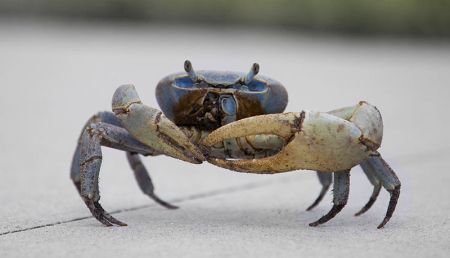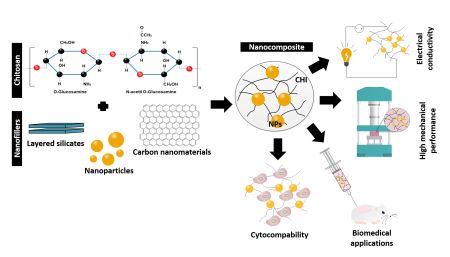|
|
|
|
|
|
| Combining a sugar derived from crab and shrimp shells with nanomaterials could lead to applications that enhance bone regeneration and wound healing. |
TSUKUBA, Japan, Oct 24, 2016 - (ACN Newswire) - A review of the latest research shows that combining a sugar, obtained from crab and shrimp shells, with a variety of nanomaterials could lead to the development of biomedical applications that enhance bone regeneration, wound healing and targeted drug delivery.
 | | Chitosan is a sugar that is typically derived from shrimp and crab shell waste. Copyright: Alex Barabas |
 | | Chitosan nanocomposites based on distinct inorganic fillers, such as layered silicates, nanoparticles and carbon nanomaterials, for biomedical applications. |
The review, published in the journal Science and Technology of Advanced Materials, provides an overview of the different nanomaterials that are being tested in combination with chitosan, the methods used to prepare the composite materials and the resultant properties that make them suitable for applications in the biomedical field.
Chitosan is a sugar that is typically derived from shrimp and crab shell waste and is known for its biocompatible, biodegradable, antibacterial, antifungal, analgesic and haemostatic (stops bleeding) properties. This makes it an excellent candidate for a number of biomedical applications, if not for the fact that it has limited mechanical strength. Researchers are working on developing composites that combine chitosan with "nanofillers", making the resulting material stronger. A successful composite is one in which the filler is well-dispersed within the composite material, so that it can interact strongly with chitosan.
Scientists are finding some success in combining bioactive glass nanoparticles with chitosan to develop synthetic bone grafts. Bioactive glass is a glass-ceramic biomaterial that binds well to physiological structures such as bone. Bone cells were found to grow relatively quickly and cover grafts made of bioactive glass and chitosan.
Graphene oxide has been used in combination with chitosan to develop "nanocarriers" that can deliver drugs to target tissues, avoiding the negative side effects that conventional drugs can have on other tissues of the body.
Silver nanoparticles are being tested as nanofillers in combination with chitosan to develop wound dressings with antibacterial properties.
Also, haemoglobin (the protein in red blood cells that carries oxygen through the body), silver nanoparticles and graphene have been combined with chitosan to develop a biosensor that can detect hydrogen peroxide, a dangerous by-product of some industrial processes.
Further research is needed. More focus is required on improving the dispersion of nanofillers within the chitosan matrix, the researchers say. How these composite materials degrade is another area that needs further pursuit. Also, more research is needed to understand how these composite materials interact with host tissues in the body and whether these materials can be sterilized using conventional methods so that they can be applied in clinical practice.
"The vast opportunities shown by these materials, allied with their incredible nanotechnology potential, is expected to revolutionize the biomedical field in the near future," the researchers conclude.
For further information please contact:
Duarte Moura (*)
Universidade do Minho - Campus de Azurem Ringgold standard institution, Portugal
*E-mail: dualex_moura@hotmail.com
Professor Joao Mano,
3B's Research Group in Biomaterials, Biodegradables and Biomimetics
Professor Conceicao Paiva,
Institute for Polymers and Composites/I3N, Department of Polymer Engineering, University of Minho
Professor Natalia Alves,
3B's Research Group in Biomaterials, Biodegradables and Biomimetics
Article information
Duarte Moura(*), Joao Mano, Conceicao Paiva, Natalia Alves,
"Chitosan nanocomposites based on distinct inorganic fillers for biomedical applications",
Science and Technology of Advanced Materials Vol. 17 (2016) p. 1229104.
http://dx.doi.org/10.1080/14686996.2016.1229104
http://tandfonline.com/doi/full/10.1080/14686996.2016.1229104
Journal information
Science and Technology of Advanced Materials (STAM, http://www.tandfonline.com/toc/tsta20/current) is an international open access journal in materials science. The journal covers a broad spectrum of topics, including synthesis, processing, theoretical analysis and experimental characterization of materials. Emphasis is placed on the interdisciplinary nature of materials science and on issues at the forefront of the field, such as energy and environmental issues, as well as medical and bioengineering applications
For more information about STAM contact
Mikiko Tanifuji
Publishing Director
Science and Technology of Advanced Materials
E-mail: TANIFUJI.Mikiko@nims.go.jp
Topic: Research and development
Source: Science and Technology of Advanced Materials
Sectors: Materials & Nanotech, Science & Research
http://www.acnnewswire.com
From the Asia Corporate News Network
Copyright © 2026 ACN Newswire. All rights reserved. A division of Asia Corporate News Network.
|
|
|

|
|
|
|
| Science and Technology of Advanced Materials |
| July 8, 2025 06:48 HKT/SGT |
|
Progress towards potassium-ion batteries |
| June 23, 2025 00:15 HKT/SGT |
|
New method to blend functions for soft electronics |
| May 5, 2025 03:20 HKT/SGT |
|
New Database of Materials Accelerates Electronics Innovation |
| Jan 28, 2025 08:00 HKT/SGT |
|
High-brilliance radiation quickly finds the best composition for half-metal alloys |
| Dec 3, 2024 23:15 HKT/SGT |
|
Machine learning used to optimise polymer production |
| Oct 25, 2024 23:00 HKT/SGT |
|
Machine learning can predict the mechanical properties of polymers |
| July 30, 2024 20:00 HKT/SGT |
|
Dual-action therapy shows promise against aggressive oral cancer |
| Apr 17, 2024 22:00 HKT/SGT |
|
A new spin on materials analysis |
| Apr 12, 2024 18:00 HKT/SGT |
|
Kirigami hydrogels rise from cellulose film |
| Feb 27, 2024 08:00 HKT/SGT |
|
Sensing structure without touching |
| More news >> |
 |
|
|